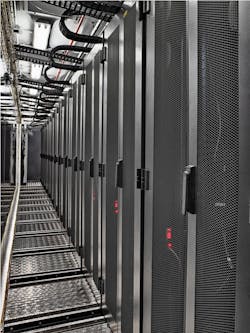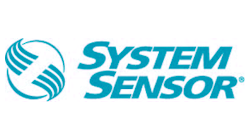Although there is a low probability of fire in data centers, a small fire in a single piece of electronic equipment can result in huge damage and costly interruption of IT operations and services.
Lost revenue is a direct result of unplanned downtime. The Aberdeen Group estimates the average loss at $138,000 per hour. Indirect costs — such as lost employee productivity, the cost of time to recreate lost work, damage to a firm’s reputation or brand, and losing customers — are more difficult to quantify but perhaps just as significant. Therefore, very early warning fire detection, which can be provided by aspiration systems, is critical for identifying such small fire events like precursor smoldering or overheating equipment.
As data center criteria evolve, fire protection technologies and strategies continue to acclimate to provide integrated solutions.
Although spot detectors are sometimes considered for these contained applications, their performance is often impaired by the high airflow needed in a data center and the limitations of detecting smoke at a spot location subject to high airflows. Air sampling detection can overcome these limitations and offer advantages over spot detectors. These systems operate over a wide range of airflows, from 0 to 4000 fpm, and can be programmed for sensitivities ranging from early warning to very early warning type detection.
Data center fire protection strategies often integrate numerous facets into one solution, such as a combination of suppression and smoke detection systems.
When suppression systems are installed as part of a data center’s fire protection strategy, there is a need to identify and investigate an alert or alarm condition prior to an extinguishing suppression system’s operation. Depending on the suppression system used, there could be a need for a fire detection system interface to initiate sprinkler pre-action valve operations or damper-closing operations prior to clean agent release or to shut down HVAC systems and other equipment.
Case in Point: Per Mar Security Services
Iowa-based integrator Per Mar Security Services took advantage of its security and fire system expertise to produce its own 500-sq-ft.cutting-edge data center to support its core business. “We are always looking for new ways to improve service, and that includes our own support, “says Daniel Turner, Per Mar’s Chief Information Officer.
Per Mar’s data center was built using AST modular Smart Shelter Containers. The former shipping containers provide security and fast deployment, ensure perfect internal environmental conditions, and protect the contents from external hazards or natural disasters.
Per Mar designed a cross-zoned, HFC-125 clean agent gas suppression system supported by four heat detectors and four smoke detectors — all networked to a control panel. An aspirating smoke detector was also tied to the panel, as well as the automation platform, to communicate alarm levels, urgent or minor faults, and other status conditions to appropriate personnel.
Aspiration detection played an important role in these operations by providing alerts and alarms at appropriately set smoke detection levels. If there is a threatening fire in development, an alarm setting can be programmed to initiate pre-action valve or clean agent release. Where a sprinkler or water mist system is supplemented by a clean agent system, it may be necessary to control suppression/extinguishing system operations with two alarm levels of an air sampling detector (e.g. Fire Alarm 1 and Fire Alarm 2) or to use two independent detection systems.
When depowering— shutting down HVAC systems and equipment that’s a potential ignition source — is necessary, it can be accomplished with either manual or automatic disconnect features. Aspirating smoke detection can also be valuable to the sequence of depowering operations.
Premature shutdown of HVAC systems can cause an immediate temperature spike in the facility, resulting in electronics equipment damage. Early staff response initiated by an aspirating smoke detection system’s alert and action settings can confirm the need for any associated air handling shutdown.
In the event of an actual fire, the typical Fire 1 and Fire 2 alarm settings can be programmed to initiate pre-action valve release (or clean agent release) and HVAC shutdown and equipment depowering. The depowering of equipment assures better clean agent suppression and less chance of equipment damage.
“It gives early warning or very early warning, depending on how you configure it, and we can check into a potential problem before it actually arises — which absolutely is beneficial to the data center,” Turner says.
Code Compliance: Aspiration in IT Equipment Spaces
Concealed spaces are common within data centers, such as areas above ceilings and below raised floors. Such spaces are generally protected with detection systems, yet do not meet appropriate standards. NFPA 75, Standard for the Fire Protection of Information Technology Equipment, and insurance carriers have specific requirements for areas above ceilings and below raised floors that contain cables. Highly protected risk insurance standards tend favor very early warning fire detection provided by aspirating detection system technology.
Raised Floors: NFPA 75 requires automatic detection systems below raised floors of IT equipment areas that contain combustible cables. Both thermal and non-thermal damage can result if PVC cables or other plastics ignite. Early detection provided by air sampling technology can minimize the risk of damage to equipment from ignited plastic cables. Furthermore, these systems can provide condition alerts in the raised floor to prompt appropriate personnel to remove tiles and locate the issue.
One of the design challenges for the Per Mar data center was accommodating a 14-inch raised floor. The aspiration piping was installed so it could sample the air both above and below the floor. “You have to adjust your mindset when designing and installing an aspiration system,” explains Kevin Link, Manager of Per Mar’s Technical Services Department. “For example, if installing traditional duct detectors, four to six holes per 12 inches would be needed on a duct detector sample tube. An aspiration system with 50 to 60 feet of pipe would only need four holes to cover the same area.”
Above Ceiling/Below Floor Air Handling Spaces: The ceiling plenums and below floor/within wall spaces that define the IT equipment space are often used for air circulation from other building spaces. Consequently, there may be smoke dampers or other protective openings for air return or supply. NFPA 75 requires detection to initiate closing these openings, as well as smoke dampers to eliminate smoke contamination of the IT equipment space. NFPA 75 requires one or more of the following three methods to be used:
- Detection throughout the above ceiling space or below floor air circulation space;
- Detection located at each smoke damper; or
- Detection at other locations where smoke may transported into the IT equipment space. (e.g. door opening from a non-IT equipment space).
Aspirating technology can easily identify smoke contamination from IT equipment space fires by placing air sampling points at each damper location that will help to sense smoke and initiate the damper closing operation. If a large number of dampers or other openings need to be controlled, then it may be beneficial to install detection sampling points throughout the ceiling plenum or raised floor plenum. This can be an effective installation because these concealed spaces may have wiring and cables that warrant detection.
Ceiling Level: Airflow path locations, such as return air grills or in-duct air sampling points, are often convenient locations for air sampling points. NFPA 75 requires early warning automatic detection systems at the ceiling level throughout IT equipment areas. Although various types of detection could fulfill this requirement, NFPA 75 does note that air sampling detection devices should be considered due to the high-airflow nature of the data center environment.
Aspirating detection at the ceiling fulfills basic or high sensitivity detection throughout the space, whether the data center is operating in full air movement mode or undergoing a service outage or equipment replacement. Packaging materials and combustible boxes can present a transient fire risk during equipment upgrades and layout changes, but continuous ceiling-level air sampling detection can monitor such combustible fire risks.
Other Risks
HVAC systems (usually referred to as CRAC or CRAH units in data centers) monitor and maintain the temperature, air distribution, and humidity in a network room or data center. Fan motors, fan belts, power wiring, and filters are potential ignition and fire sources. A smoldering wire or small filter ignition can introduce smoke into the cooling air stream. Consider placing aspiration air sampling points downstream of the filters on the supply air side of the CRAC or CRAH units to recognize smoke before it circulates through sensitive electronics.
Additionally, outdoor fires and fires in properties adjacent to a data center can pose a risk of smoke and chemical contamination. HVAC systems that draw outside air and use energy-saving economizer cycles can quickly introduce smoke-laden air into the data center. The economizer cycle saves energy in buildings by using cool, dry outside air as a means of cooling the indoor spaces, but is not typically deployed in hot, humid climates.
Bernard Sokol is Sr. Product Marketing Manager for System Sensor. To request more info about the company, visit www.securityinfowatch.com/10215277.



